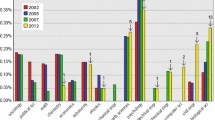Abstract
Like other OECD nations, Australia is facing a crisis in the academic staff of its universities over the next two decades. This is a function of several factors, among which demographic elements are especially significant. The academic workforce of Australia is characterized by three distinct demographic features — age heaping, a concentration in older ages, and gender imbalance. The first two are a result of rapid expansion in the late 1960s and 1970s when the numbers of students expanded exponentially with the passage of the post-war baby boom cohorts into the university entrance ages and greatly increased participation rates. This, together with increases in student/staff ratios and perhaps the increased attractiveness of alternative vocations, has created a dearth of young academics. The impending and actual retirement of the bulge means that there will be a tightening of the academic labor market and an increase in demand for university staff unprecedented for three decades. This will occur in a context where the number of Australian graduates moving to foreign universities is increasing rapidly as a result of further internationalization of the labor market. Some of the challenges and opportunities that this presents are discussed.










Similar content being viewed by others
Notes
Industry (ANZSIC) Class — 8431 Higher Education (this class consists of establishments engaged in providing university undergraduate or post-graduate teaching or research). Selected occupations — those listed below were selected as (in totality) they would generally represent ‘academic staff’. Occupations such as clerks, tradespersons, technical assistants, librarians, and general administrative and managerial staff are specifically excluded. Selected occupations (ASCO2): 1293 Education managers (include. Faculty Heads); 1299 Other Specialist Managers (e.g. R&D Managers); 2000 Professionals, not further defined; 211 Natural and Physical Science Professionals; 212 Building and Engineering Professionals; 223 Computing Professionals; 2293 Mathematics, Statisticians and Actuaries; 2322 Nurse Educators and Researchers; 240 Education Professionals, not further defined; 242 University Lecturers and Tutors, etc.; 249 Miscellaneous Education Professionals.
The concentration of people into a narrow range of age groups.
Males per hundred females.
Permanent movement is defined by the Department of Immigration and Multicultural and Indigenous Affairs (DIMIA) as persons migrating to Australia and residents departing permanently; Long-term movement is defined by DIMIA as temporary visa holders arriving and residents departing temporarily with the intention to stay in Australia or abroad for 12 months or more, and the departure of temporary visa holders and the return of residents who had stayed in Australia or abroad for 12 months or more.
References
Australian Bureau of Statistics (ABS). (1997) Australian Standard Classification of Occupations (2nd edn), Catalogue no. 1220.0, ABS: Canberra.
Australian Bureau of Statistics. (2003a) Census of Population and Housing; Data Quality — Undercount, Information Paper, Catalogue no. 2940.0, Canberra, 35pp.
Australian Bureau of Statistics. (2003b) Labour Force Australia, Catalogue no. 6203.0, Canberra: ABS, 80pp.
Australian Bureau of Statistics. (2004) Year Book Australia 2004, Catalogue no. 1301.0, Canberra: ABS, 872pp.
Birrell, B, Dobson, IR, Rapson, V and Smith, TF (2001) Skilled Labour: Gains and Losses, Canberra: DIMIA, 36pp.
Borrie, WD (1962) ‘Schools and universities and the future: some observations based on statistics’, Vestes 5: 42–49.
Costello, P (2002) Intergenerational Report 2002–03, 2002–03 Budget paper no. 5, Canberra: Commonwealth of Australia, 94pp.
Costello, P (2004) ‘Australia's demographic challenges’, Discussion paper 25, 28pp.
Department of Education, Science and Training. (2004) Students 2003: Selected Higher Education Statistics [WWW document] http://www.dest.gov.au/highered/statistics/students/03/student_tables/tables.htm (accessed November 2004).
Department of Education, Training and Youth Affairs. (2001) Higher Education Students Time Series Tables, Canberra: Australian Government Publishing Service, 56pp.
Hugo, G, Rudd, D and Harris, K (2003) Australia's diaspora: it's size, nature and policy implications, CEDA Information paper no. 80, 88pp.
Hugo, G, Rudd, D and Harris, K (2001) Emigration from Australia: economic implications, Second Report on an ARC SPIRT Grant, CEDA Information paper no. 77, 110pp.
Hugo, G (2004) Some geographical dimensions of Australia's diaspora, St Andrews: Paper presented at Second International Population Geographies Conference, pp. 11–14.
Khoo, S, Voight, C, Hugo, G and McDonald, P (2003) ‘Temporary skilled migration to Australia: the 457 visa sub-class’, People Place 11, 4: 27–40.
McDonald, P, Khoo, SE and Kippen, R (2003) ‘Alternative net migration estimates for Australia: exploding the myth of a rapid increase in numbers’, People Place 11, 3: 23–36.
National Population Inquiry. (1975) Population and Australia: A Demographic Analysis and Projection two volumes, Canberra: Australian Government Publishing Service, 759pp.
Perry, L (2004) ‘Fears huge classes add to attrition rates’, The Australian 28 July.
Probert, B (1999a) ‘Gender pay equity in higher education’, in: P. Fogelberg (ed.) Hard Work in the Academy: Research and Interventions on Gender Inequalities in Higher Education, Helsinki: Helsinki University Press, pp. 136–154.
Probert, B (1999b) ‘Gendered workers and gendered work: implications for women's learning’, in: D. Boud and J. Garrick (eds.) Understanding Learning at Work, London: Routledge, pp. 98–116.
Probert, B (1999c) ‘Men and women in Australian Higher Education’, in: P. Fogelberg, J. Hearn, L. Husu and T. Mankkinen (eds.) Hard Work in the Academy: Research and Interventions on Gender Inequalities in Higher Education, Helsinki: Helsinki University Press.
Probert, B (1999d) ‘Working in Australian universities: pay equity for men and women?’, in: D. Cohen, A. Lee, A. Payne, H. Scheeres, L. Shoemark and S. Tiffin (eds.) Winds of Change: Women and the Culture of Universities Conference, Sydney: University of Technology Sydney, pp. 173–185.
Thomas, J (2000) Mathematical Sciences in Australia: Looking for a Future, FASTS Occasional Paper Series, No. 3, October, 32pp.
Thomas, J (2002) Mathematical Sciences in Australia: Still Looking for a Future, FASTS Occasional Paper Series, May, 13pp.
Wood, FQ (ed) (2004) ‘Beyond brain drain’; mobility, competitiveness and scientific excellence, Proceedings of a workshop held at the Queensland Bioscience Precinct, Canberra: Federation of Australian Scientific and Technological Societies, 184pp.
Author information
Authors and Affiliations
Rights and permissions
About this article
Cite this article
Hugo, G. Some emerging demographic issues on Australia's teaching academic workforce. High Educ Policy 18, 207–229 (2005). https://doi.org/10.1057/palgrave.hep.8300084
Published:
Issue Date:
DOI: https://doi.org/10.1057/palgrave.hep.8300084




